Consider this scenario: You've built a terrific product in which you've invested time and money, and are ready to launch in the market.
Unfortunately, your brilliant concept did not catch on. As a result, none of your investments ever yielded a profit. This happened because you failed to validate your concept.
Now that you’re building again, you don’t want to go through the same pain and waste your precious time and money, right?
We'll show you how to verify product ideas the right way.
But first, let’s understand why validating your startup idea is so important?
How validation of startup helps
Validation provides you with the assurance that your firm will have a sustainable, expanding, and paying market in a fairly short time. It stood you from investing months or years in developing a final product that no one will pay for. It's a style of thinking as well as a step-by-step method.
The final goal of validation is to meet a target number of pre-orders or waiting list subscribers. This group would buy a basic proof of concept for your idea. You will present them with a deliverable product that satisfies the most basic version of the problem you're trying to solve.
1. Write down your expectations
The process of writing compels you to think about topics you may have previously overlooked. I'm not referring to the creation of a "business strategy." (A business plan isn't the greatest use of time for a company since it will alter as soon as you start talking to potential consumers.)
We're talking about figuring out the answers to a few crucial questions that you have to put on the test. These are your expectations, and as early on you can test them, the lower the danger during product launch.
To get you started, consider the following questions. Make a list of some fundamental assumptions that you can test:
Who is your target market? When you say "everyone," you're already putting yourself in a difficult situation. Make certain to be specific. For example, if your customer is a business, respond as follows:
- What type of firm are you talking about?
- What is the usual size of these firms?
- Are they all in the same industry?
What issues are you attempting to resolve? So many entrepreneurs focus on the product first, obsessing over the features, launching the product, and then wondering why it isn't gaining momentum. Our recommendation is to begin with the problem.
Be clear about the challenges that your solution solves. You may confirm if clients regard these issues as problems by writing them down and testing them on people. And, maybe more crucially, whether customers believe these are issues worth resolving.
How does your product address these issues? You don't go on to the product until you've written down the problem. From here, you may immediately link the value of your product to consumer concerns.
- How can resolving their issues improve their lives?
- Is it making them additional money?
- Do you think you look better now?
What are the product's main features? The features must be more than just attractive; they must also answer specific difficulties. The more quantifiable (for example, time saved or money earned), the better. Conceive your ideas to create a minimum viable product and keep the feature set as small as possible.
2. Make your call
You have written down your assumptions, it's time to validate your product concept now.
The first stage in the validation process is to assemble a small, closed group of beta testers from your target market who can assess your product idea, provide input, and assist you in identifying flaws.
We're attempting to accomplish a few goals here:
To find out how many people are interested in our proposal
To gain a better understanding of their demands and to enhance our product concept accordingly.
There are various options for doing so.
If you have a mailing list, send out an email introducing your product concept and asking if people want to learn more about it.
If you don't already have a mailing list, Facebook is an excellent platform to start gathering input for your product concept. To locate related groups, simply go to Facebook Groups and search for your topic.
Also, check for organisations in other closely comparable categories where your product concept could be of interest.
If you are making a protein supplement for gym-goers, people who are interested in healthy living, physical fitness, motivation, and other topics will most likely be interested in your product as well.
Participate in at least 10–15 active groups and spend a few days replying to other members' posts and comments. Once people are comfortable with you, share your concept with them and ask for feedback on how to improve it.
Also Read:- Building a Startup? You Need to Learn to Negotiate.
3. Packaging is important
There's a difference between your main product and the complete package that customers will pay for.
Confused?
Assume your main product is a video course with seven or eight sections. However, there are a few things you can do to boost its perceived worth and make it more appealing to purchasers.
Worksheets, supplementary reading material, interviews with successful students, a members-only Facebook Group, or even a 30-minute consulting call with you are all possibilities. You'd be shocked how many people would buy your goods just because it includes something extra in addition to the primary offering.
This also allows you to debut your product at a higher price point and provide several bundles with variable prices to appeal to different types of customers.
4. Creating the landing page
Since you know what your product is going to be like, you'll need to develop a landing page to tell customers about it and encourage them to buy it from you even before it's finished.
Many marketers use an email opt-in landing page over a product sales page at this point. That's a huge blunder. Keep in mind that your goal isn't to increase your subscriber base or establish a list of freebie seekers.
You want to verify your product concept, and despite all of your study and effort spent evaluating your competition, there's no better way to do so than to make people pay for it. You can sell a product to thousands of people after it's ready if you can persuade 5 to 10 strangers to pay for it before it's ready.
What are your plans for the landing page? You'll describe your tale, explain what your product is all about, and offer a full overview of it.
Here, you can hire the top website developers from India for your landing page creation.
In addition, you'll either write an executive summary-style text or a 5- to 7-minute film that explains exactly what customers are signing up for. A visual is a more captivating kind of material than a written text. But depending on the kind of product you are selling, text might be a better option.
It's critical to employ landing page builders' A/B testing functionality during validation tests. You'll learn useful information that can aid you in developing your MVP and marketing plan.
Experimenting with your headline and tagline can help you convert more customers. In addition, you'll have a better idea of what connects with your target audience. So you've got a landing page up and running (with at least two versions).
5. Getting your first buyer
Send an email to your inner circle (the individuals who helped you create your product concept) before releasing it to the public. Offer them exclusive pricing that will not be available to anyone after the product is out. Send them to the landing page you just designed to seal the deal.
Send this to your email list, as well as any connections you've gathered through Facebook Groups, Quora, Reddit, Instagram, or other online communities.
If you've done everything correctly thus far, this email will almost certainly result in your first transaction.
Also Read:- WHAT MAKES DIGITAL MARKETING A MUST HAVE FOR ANY BUSINESS TODAY?
The entrepreneur way of life
Idea validation is carried out to reduce the danger of adopting ideas that no one wants or will pay for. The goal of concept validation is to ensure that your product or company idea has potential and that your most important assumptions are correct. The goal is to identify the quickest and least expensive approach to test your assumptions so you can determine whether to pursue the concept or pivot.
If you don't acquire the desired number of sales, it's time to modify your concept and make it more interesting.
Even so, you'll save countless hours and thousands of rupees compared to launching your product without first verifying it. However, if your idea has been proven, it's time to go to work. Convert your validated idea into a product that exceeds expectations and delights your consumers.
Good luck with your validation!



























